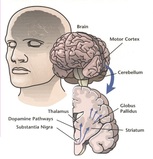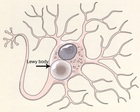Parkinson's Disease
What Causes Parkinson's Disease?
A Shortage of Dopamine
Parkinson's disease occurs when nerve cells, or neurons, in an area of the brain that controls movement become impaired and/or die. Normally, these neurons produce an important brain chemical known as dopamine, but when the neurons die or become impaired, they produce less dopamine. This shortage of dopamine causes the movement problems of people with Parkinson's.
Dopamine is a chemical messenger, or neurotransmitter. Dopamine is responsible for transmitting signals between the substantia nigra and multiple brain regions. The connection between the substantia nigra and the corpus striatum is critical to produce smooth, purposeful movement. Loss of dopamine in this circuit results in abnormal nerve-firing patterns within the brain that cause impaired movement.
Loss of Norepinephrine
People with Parkinson's also have loss of the nerve endings that produce the neurotransmitter norepinephrine. Norepinephrine, which is closely related to dopamine, is the main chemical messenger of the sympathetic nervous system. The sympathetic nervous system controls many automatic functions of the body, such as heart rate and blood pressure. The loss of norepinephrine might help explain several of the non-movement features of Parkinson's, such as fatigue, irregular blood pressure, decreased gastric motility or movement of food through the digestive tract, and postural hypotension. Postural hypotension is a sudden drop in blood pressure when a person stands up from a sitting or lying-down position. It may cause dizziness, lightheadedness, and in some cases, loss of balance or fainting.
Lewy Bodies in Brain Cells
Many brain cells of people with Parkinson's contain Lewy bodies. Lewy bodies are unusual deposits or clumps of the brain protein alpha-synuclein, along with other proteins, which are seen upon microscopic examination of the brain. Researchers do not yet know why Lewy bodies form or what role they play in the development of Parkinson's. The clumps may prevent the cell from functioning normally, or they may actually be helpful, perhaps by keeping harmful proteins "locked up" so the cells can function.
Genetic Mutations
Althoug some cases of Parkinson's appear to be hereditary, and a few can be traced to specific genetic mutations, most cases are sporadic. Sporadic means the disease occurs randomly and does not seem to run in families. Many researchers now believe that Parkinson's disease results from a combination of genetic and environmental factors.
Scientists have identified several genetic mutations associated with Parkinson's including mutations in the alpha-synuclein gene. They think that many more genes may be linked to the disorder. Studying the genes responsible for inherited cases of Parkinson's can help researchers understand both inherited and sporadic cases. The same genes and proteins that are altered in inherited cases may also be altered in sporadic cases by environmental toxins or other factors. Researchers also hope that discovering genes will help identify new ways of treating Parkinson's.
Environmental Toxins
Although researchers increasingly recognize the importance of genetics in Parkinson's disease, most believe environmental exposures increase a person's risk of developing the disease. Even in inherited cases, exposure to toxins or other environmental factors may influence when symptoms of the disease appear or how the disease progresses.
There are a number of toxins that can cause parkinsonian symptoms in humans. Researchers are pursuing the question of whether pesticides and other environmental factors not yet identified also may cause Parkinson's disease. Viruses are another possible environmental trigger for Parkinson's.
Mitochondria and Free Radicals
Research suggests that mitochondria may play a role in the development of Parkinson's disease. Mitochondria are the energy-producing components of the cell and are major sources of free radicals. Free radicals are molecules that damage membranes, proteins, DNA, and other parts of the cell. This damage is called oxidative stress. Changes to brain cells caused by oxidative stress, including free radical damage to DNA, proteins, and fats, have been found in people with Parkinson's. Clinical studies now underway test whether agents thought to improve energy metabolism and decrease oxidative stress slow the progression of Parkinson's disease. Recent evidence suggests that mutations in genes linked to Parkinson’s disease result in mitochondrial dysfunction.
Buildup of Harmful Proteins
Other research suggests that the cell's protein disposal system may fail in people with Parkinson's, causing proteins like alpha-synuclein to build up to harmful levels and trigger premature cell death. Additional studies have found that clumps of protein that develop inside brain cells of people with Parkinson's may contribute to the death of nerve cells, or neurons. However, the exact role of the protein deposits remains unknown. These studies also found that inflammation, because of protein accumulation, toxins or other factors, may play a role in the disease. However, the exact role of the protein deposits remains unknown. Researchers are exploring the possibility of vaccine development to decrease or prevent the accumulation of alpha-synuclein.
While mitochondrial dysfunction, oxidative stress, inflammation, and many other cellular processes may contribute to Parkinson's disease, scientists still do not know what causes cells that produce dopamine to die.
Genes Linked to Parkinson’s
Researchers have discovered several genes that are linked to Parkinson's disease. The first to be identified was alpha-synuclein or SNCA . Studies have found that Lewy bodies from people with the sporadic form of Parkinson's contain clumps of alpha-synuclein protein. This discovery revealed a possible link between hereditary and sporadic forms of the disease. Other genes linked to Parkinson's include PARK2, PARK7, PINK1, and LRRK2. PARK2, PARK7, and PINK1 cause rare, early-onset forms of the disease. Mutations in the LRRK2 gene are common in specific populations, including in people with Parkinson's in North Africa.
Researchers are continuing to study the normal functions and interactions of these genes in order to find clues about how Parkinson's develops. They also have identified a number of other genes and chromosome regions that may play a role in Parkinson's, but the nature of these links is not yet clear. Whole genome wide association studies, or GWAS, of thousands of people with Parkinson's disease are now underway to find gene variants that allow for an increased risk of developing Parkinson's but are not necessarily causes of this disorder by themselves.
A recent international study found that two genes containing mutations known to cause rare hereditary forms of Parkinson’s disease are also associated with the more common sporadic form of the disease. This finding came from a GWAS which looked at DNA samples of European people who had Parkinson’s disease and from those who did not have the disorder.






